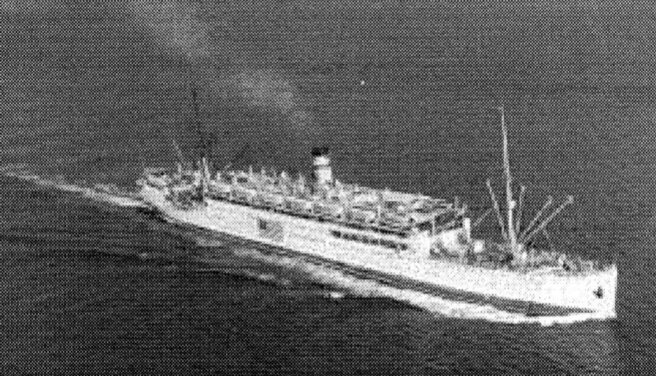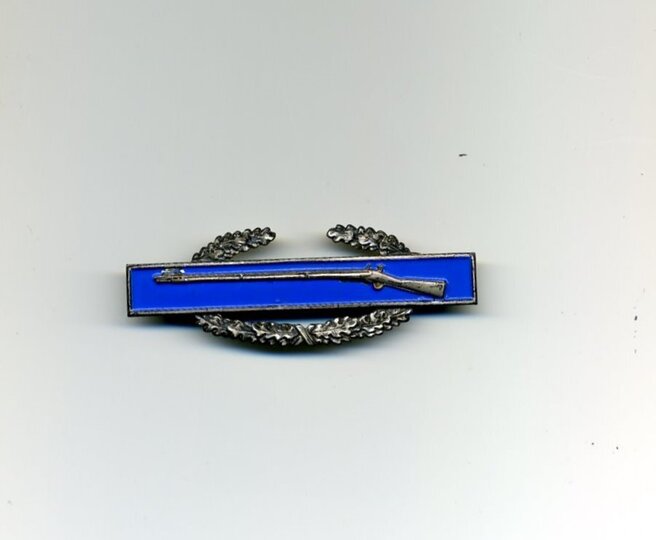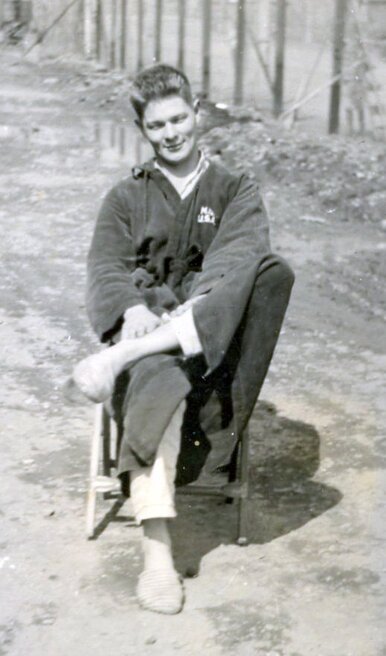- 88 years old
- Born on December 17, 1921
- Passed away on July 26, 2010
This memorial website was created in the memory of our loved one, Wayne Walters. We will remember him forever.

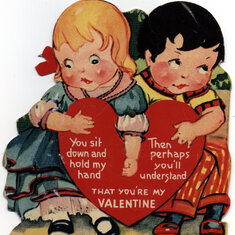
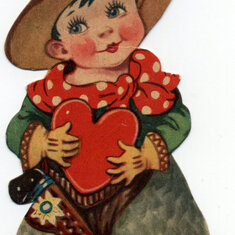
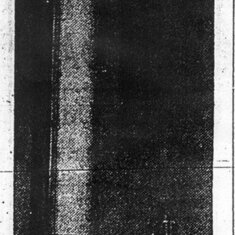



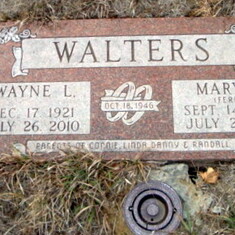
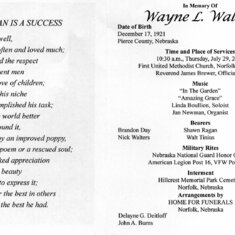
He shipped out on the USS U.S. Grant from San Francisco in January, 1945.The trip took about 30 days, and was calm enough, the ship stopping twice for supplies at New Guinea.Ship quarters were very tight and only two meals a day were provided.With such extremely short rations the men were always hungry.Wayne volunteered for ‘KP’ duty in the kitchen—just so he could get extra food to eat.“Extras” were hard to come by so an apple stashed in his pocket easily brought a dollar from another hungry serviceman.Time hung heavy on their hands after routine drills and chores, so gambling became an easy and natural way to pass the long hours at sea.Wayne joined the crowd, winning at craps, but losing at poker.In total, his tour of duty provided some gripping raw material for many anecdotes, some of which he later told with humor, but some were never told.(See note about the US Grant at the end of this story).
The 100-ship convoy landed at Leyte in the Philippines. At Manila they left the train which had brought them closer to the front lines in the north.There he joined his Division as a replacement.Getting enough to eat was still an issue, so at night men took turns foraging in the camp kitchens.Sometimes they were lucky and got gallons of fruit, but Wayne’s turn got him a can of peanut butter—but it didn’t go to waste.He was one of a 3-man automatic rifle
team and a bit unhappy when he was issued a sniper bolt action rifle (.03)—accurate but slow, and which he quickly discarded. As some of the men in battle went down, their better weapons were quickly retrieved and used by other infantrymen. Wayne later had a chance to get a heavy Browning automatic rifle, along with 2 assistants to carry the ammunition.
Wayne was in heavy active duty in the Philippines for about 7 months from February until August of 1945.According to official Luzon Battle accounts, by February of 1945 U. S. troops had largely defeated the Japanese in the south and pushed them out of Manila to the north end of Luzon Island. In late February and early March the 33rd Division had considerable success overrunning Japanese positions and thus encouraged, their commander Maj. General Perce Clarkson, proposed and General Swift, Corps I commander agreed, to order Wayne’s33rd Division, which had come up as replacement for the depleted and battle weary earlier Divisions, to push hard north toward Baguio. Baguio was the prewar summer capital and also the northeast headquarters of General Yamashita and his remaining Japanese forces in the Philippines. But the 33rd Division was then outnumbered two to one by the Japanese, and progress was slow along the road to Baguio due to strong pockets of resistance from the enemy dug into the mountains all around Baguio. Casualties were heavy on both sides. Wayne recalled vividly the time his Division was fighting on one side of a mountain at Baguio.The 130-man Division had dug their own foxholes and were under intense fire; men were ordered to not leave their foxholes at night,—anyone or anything moving would be shot.One of Wayne’s unpleasant memories—not far from his foxhole one man did crawl out in the darkness.He was shot and cried out for help.It was a long night for all those troops who bore the brunt of the fallen soldier’s death cries—“you shot me”.Obeying orders, no one, not even the medics,moved out of cover.Finally death brought silence.Wayne and an artillery observer in the foxhole next to him had earlier worked out a signal—they tied a cord to each other’s arm so that when one needed to wake the other, a pull on the line would do it…no betraying sound or risky movement.
The high ridge would be difficult to take, and the men knew they were “bait” when ordered to take the ridge at all costs, so movement was a slow crawl.Even the commanding officer couldn’t speed up their climb up the mountain.Out of 130 men in Wayne’s Division, at the end of this battle, Wayne was able to count only 27 men left.That made a lasting impression.Thousands of Japanese retreated farther into the mountains and dugpermanent caves, where some lived for years even after the war ended, before being discovered. Routinely no American officer wore insignia, as officers were the first ones shot.Later at camp inspection, Wayne recognized the inspecting officer as the one in the foxhole next to him on the mountain. The officer never said a word but a wink was his recognition to Wayne—he was the other man with the cord signal.
In a few of these front line battle areas not the best feelings developed toward the “black”-Negro soldiers—after some of those truck drivers would not deliver needed supplies to the men fighting in the front lines.They did not seem to have the same “win the war” spirit—they simply stopped their trucks and refused to get close to the fighting.So “white” soldiers had to leave their battle positions, go back, and drive supply trucks up to the front with the needed supplies.Later several black troops were heard bragging to Philippine women how they were special night troops in battle—the reality was that some never got close to the fighting if they could avoid it.White soldiers went to town in groups due to this friction which was not forgotten by a number of soldiers from the front lines.And there were later incidents when several “black” men were shot, prompting recall of all arms from the troops for a short time, as outside of the actual war zone heavy arms were not needed.
THE WAR YEARS - Drafted Again 1944-1946
Six months later he was drafted again and in less than another six months he was fighting in the front lines in the Philippines. Wayne’s World War II memories cover the range of good and bad—admiration of the brave soldiers following orders even when questionable; as well as disgust at times over shirking combatants, and laughs at the “goldbrickers”.
Wayne Leonard Walters was inducted into military service September 28, 1944, processed at Ft. Leavenworth, Kansas; then arrived Oct. 14, 1944, at Camp(Ft.) Hood, Texas, for basic training.After 3 months training as combat infantryman, Wayne was Private 1st Class in the U. S. Army, 33rd Division, 136th Infantry Regiment, Company G, Serial No. 37 752 997.His training included rifle, machine gun and mortar, and he certainly could handle his rifle as well as any man.But Wayne liked to tell the story that to speed up the marksman training session in bad weather, officers hastily classed all the men as “qualified”.Impossible! the commander said—pick out 10% to be “qualified”.Wayne was in that 10%. In addition to the weapons and anti-tank training, there were all kinds of field and survival training exercises.In Wayne’s booklet “I Am A Doughboy”, Generals give tribute to the value of the “foot soldiers”—the infantrymen—with an authoritative quote from George S. Patton, Jr.:“Never overlook the doughboy.A thousand years ago it was the foot soldiers who won and held territory, and it will be the same a thousand years from now.”
Following a short visit home for goodbyes to family, fiancé Mary Lou Ferry, and friends, he boarded a train to the west coast.This was not the Union Pacific troop train that became noted for its stopovers at North Platte during the war.Local women had formed a “canteen” there in a former Union Pacific terminal and met the trains to present gifts of food, and support to the servicemen en route to their destinations.(This North Platte “Canteen” story became a book written by Bob Greene and was made into a movie in later years.)
Early on, most trains had been commandeered by the government for military purposes.The heavy rail traffic had caused a switch of Wayne’s Company to another line heading west, probably the Burlington Northern, but this also gave him an extra day or two at home before shipping out.Within 6 months of basic training he went from being a carpenter, to being shot at in the front lines in the Philippine Islands.
After these battles on Luzon, Wayne became very sick. No medical transportation was available so he walked from the front lines, stepping over dead bodies along the way, to reach base camp, and was transported to the hospital.Doctors kept him in the hospital for 10 days diagnosed with malaria, but it turned out to be pneumonia. He recovered and returned to active duty as a combat infantryman.With all of Wayne’s front line battle experience he could have had the Purple Heart—while in the hospital in Manila with pneumonia when he was asked if he wanted a medal, he said he was not injured at the front.That didn’t matter.The officers were freely giving out Purple Hearts in the hospital to all who wanted one.Had he accepted the medal, he probably would have been discharged earlier.
Wayne’s cousin, Richard, son of Richard and Stella Walters, was also serving in the Army and was stationed north of Manila.So one day during a lull in the fighting Wayne hitchhiked on Army trucks and visited him at his base. It was at an outdoor movie near Clark Field in Manila that Wayne first heard about the bombing of Japan, and that the war was over.Pres. Truman signed the order July 31, 1945 to use the atomic bombs to save soldiers lives.The B-29 bomber Enola Gay, built at the Bellevue Martin plant, dropped the first atomic bomb—Little Boy—on Hiroshima on August 6th; and the Box Car B-29—Fat Man bomb fell on Nagasaki August 9th.Japan surrendered, unconditionally as demanded, on August 14, 1945.General Yamashita did not surrender his 50,000+ troops until after the end of hostilities August 15, 1945.
The War ended just in time, as Wayne learned that his Division was scheduled to be one of the first to go ashore in the planned military land invasion of Japan., code named Operation Downfall, planned by the Joint Chiefs of Staff and Gen. Mac Arthur and Adm. Chester Nimitz.Estimated total casualties in such an invasion were extremely high—about 90%.So the atomic bombs saved American soldiers.Demobilization couldn’t come soon enough for most servicemen.
Invite others to Wayne's website:
- Leave a tribute A tribute is a short message in memory of Wayne or a few words of support for those close to him.
- Share a story Share the brightest, most memorable moments of his life.
- Add photos Import and share photos of your loved one from your device or social media.
- Add videos Import videos from your device, YouTube and other sources.
- Add music Add Wayne's favorite songs for background or gallery listening.


